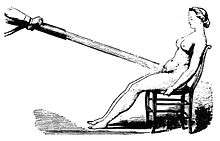Erotic massage
.jpg)
Erotic massage or sensuous massage is the use of massage techniques by a person on another person's erogenous zones to achieve or enhance their sexual excitation or arousal and to achieve orgasm. Massages have been used for medical purposes for a very long time, and their use for erotic purposes also has a long history. In the case of women, the two focal areas are the breasts and pubis, while in case of men, the focal area is the male genitals. When the massage is of a partner's genitals, the act is usually referred to as mutual masturbation.
Today, erotic massage is used by some people on occasion as a part of sex, either as foreplay or as the final sex act, or as part of sex therapy. There is also a large commercial erotic massage industry in some countries and cities.
Commercial erotic and sexual massage
An erotic and sexual massage may be provided by independent providers, providers of broader sexual services, or through organized massage parlors or brothels. It takes many forms, from massage techniques that aim to integrate the sexual, spiritual and physical, to massage whose purpose is the achievement of an orgasm through a handjob, oral sex, or sexual intercourse.
A 'happy ending' is a colloquial term for the practice of a provider offering sexual release to a client. This is sometimes offered as an addition to any other type of massage, typically in the form of a handjob. The 2009 documentary Happy Endings? follows women who worked in Asian massage parlors in Rhode Island. The film focuses on "full service" massage parlors, although "rub and tug" massage parlors (where only handjobs are offered) are also covered. Prostitution in Rhode Island was legal at the time of filming.[1]
Legality
In many jurisdictions, an erotic and sexual massage is regarded as a sexual service, the legality of which varies between jurisdictions. In some jurisdictions, an erotic massage may be legal, while prostitution is not.
Sex therapy
Erotic massage may be used in sex therapy as a means of stimulating the libido or increasing the ability of a person to respond positively to sensual stimulus. In some cases, erotic massage can be a form of foreplay without sexual gratification, intended to heighten the sensitivity of an individual prior to another engagement where sexual arousal and fulfillment is intended. In other cases, erotic massage may be used professionally to help men address issues of premature ejaculation. Methods employed may teach the recipient to relax the musculature of his pelvis and thus prolong arousal and increase pleasure.
Use in medicine


In the Western medical tradition, genital massage of a woman to orgasm by a physician or midwife was a standard treatment for female hysteria, an ailment considered common and chronic in women. In 1653, Pieter van Foreest[2] advised the technique of genital massage for a disease called "womb disease" to bring the woman into "hysterical paroxysm".
Such cases were quite profitable for physicians, since the patients were at no risk of death but needed constant treatment. However, the vaginal massage procedure (generally referred to as 'pelvic massage') was tedious and time-consuming for physicians. The technique was difficult for a physician to master and could take hours to achieve "hysterical paroxysm". Referral to midwives, which had been common practice, meant a loss of business for the physician, and, at times, husbands were asked to assist.[3]
Development of the vibrator
A solution was the invention of massage devices, which shortened the needed treatment from hours to minutes, removing the need for midwives and increasing a physician's treatment capacity. Already at the turn of the century, hydrotherapy devices were available at Bath, and by the mid-19th century, they were popular at many high-profile bathing resorts across Europe and in America. By 1870, a clockwork-driven vibrator was available for physicians. In 1873, the first electromechanical vibrator was used at an asylum in France for the treatment of hysteria.
While physicians of the period acknowledged that the disorder stemmed from sexual dissatisfaction, they seemed unaware of or unwilling to admit the sexual purposes of the devices used to treat it. In fact, the introduction of the speculum was far more controversial than that of the vibrator.
By the turn of the 20th century, the spread of home electricity brought the vibrator to the consumer market. The appeal of cheaper treatment in the privacy of one's own home understandably made the vibrator a popular early home appliance. In fact, the electric home vibrator was on the market before many other home appliance 'essentials': nine years before the electric vacuum cleaner and 10 years before the electric iron. A page from a Sears catalog of home electrical appliances from 1918 includes a portable vibrator with attachments, billed as "very useful and satisfactory for home service".[3]
See also
References
- ↑ Arditi, Lynn (2009-05-24). "Film Chronicles RI's Asian Brothels". Providence Journal.
- ↑ In a medical compendium titled Observationem et Curationem Medicinalium ac Chirurgicarum Opera Omnia
- 1 2 Maines, Rachel P. (1998). The Technology of Orgasm: "Hysteria", the Vibrator, and Women's Sexual Satisfaction. Baltimore: The Johns Hopkins University Press. ISBN 0-8018-6646-4.